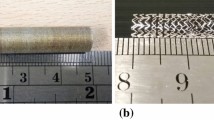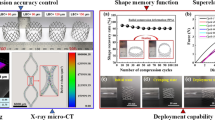Abstract
Various studies have reported 3D printing of superelastic nitinol parts. However, the sizes of samples are several scales larger than those in the biomedical applications, which provides insufficient values for the industry use. To investigate the feasibility of SLM fabrication of thinner nitinol medical devices, i.e., stent, this study has systematically explored how the process parameters affect the final quality of the printed parts. Firstly, the nitinol powders have been validated through various testings on flow property, powder behavior, and size distribution to ensure the reproducibility of nitinol devices. Then the process-microstructure-property relation of nitinol wire was investigated experimentally based on the phase transformation temperature, microstructures, phase or crystalline structures, and nickel-titanium atomic weight percentage. In the last, novel superelastic nitinol stents with two different closed-cell designs were successfully printed using the selected process parameters. A comprehensive mechanical/material characterization and biocompatibility assessment have been conducted on these 3D printed stents. In summary, this preliminary study provided a guideline on how to print thin nitinol medical devices, also demonstrated that with the suitable process parameter, it is highly feasible to use SLM to accurately print thin nitinol devices with high density, uniform strut diameters, adequate superelasticity, and excellent biocompatibility.
Graphical abstract










Similar content being viewed by others
Abbreviations
- BFE:
-
Basic flowability energy
- CBD:
-
Conditioned bulk density
- CE:
-
Circle equivalent
- DSC:
-
Differential scanning calorimeter
- EDX:
-
Energy dispersive X-ray analysis
- FR:
-
Flow rate
- FRI:
-
Flow rate index
- HS:
-
High sensitivity
- ICPMS:
-
Inductively coupled plasma mass spectrometry
- Ni:
-
Nickel
- SE:
-
Specific energy
- SEM:
-
Scanning electron microscopy
- SI:
-
Stability index
- SLM:
-
Selective laser melting
- Ti:
-
Titanium
- XCT:
-
X-ray computed tomography
- XRD:
-
X-ray diffraction
References
Aziz S, Morris JL, Perry RA, Stables RH (2007) Stent expansion: a combination of delivery balloon underexpansion and acute stent recoil reduces predicted stent diameter irrespective of reference vessel size. Heart 93(12):1562–1566. https://doi.org/10.1136/hrt.2006.107052
Frenzel J, Wieczorek A, Opahle I, Maaß B, Drautz R, Eggeler G (2015) On the effect of alloy composition on martensite start temperatures and latent heats in Ni-Ti-based shape memory alloys. Acta Mater 90:213–231. https://doi.org/10.1016/j.actamat.2015.02.029
Bimber BA, Hamilton RF, Keist J, Palmer TA (2016) Anisotropic microstructure and superelasticity of additive manufactured NiTi alloy bulk builds using laser directed energy deposition. Mater Sci Eng A 674:125–134. https://doi.org/10.1016/j.msea.2016.07.059
Habijan T et al (2013) The biocompatibility of dense and porous Nickel–Titanium produced by selective laser melting. Mater Sci Eng C 33(1):419–426. https://doi.org/10.1016/j.msec.2012.09.008
Maleckis K et al (2018) Nitinol stents in the femoropopliteal artery: a mechanical perspective on material, design, and performance. Ann Biomed Eng 46(5):684–704. https://doi.org/10.1007/s10439-018-1990-1
Wang X, Kustov S, Van Humbeeck J (2018) A short review on the microstructure, transformation behavior and functional properties of NiTi shape memory alloys fabricated by selective laser melting. Materials (Basel). https://doi.org/10.3390/ma11091683
Biffi CA, Tuissi A (2017) Nitinol laser cutting: microstructure and functional properties of femtosecond and continuous wave laser processing. Smart Mater Struct. https://doi.org/10.1088/1361-665X/aa5596
Early M, Lally C, Prendergast PJ, Kelly DJ (2009) Stresses in peripheral arteries following stent placement: a finite element analysis. Comput Methods Biomech Biomed Engin 12(1):25–33. https://doi.org/10.1080/10255840802136135
Wang J et al (2018) Endovascular stent-induced alterations in host artery mechanical environments and their roles in stent restenosis and late thrombosis. Regen Biomater 5(3):177–187. https://doi.org/10.1093/RB/RBY006
Dadbakhsh S, Speirs M, Kruth JP, Schrooten J, Luyten J, Van Humbeeck J (2014) Effect of SLM parameters on transformation temperatures of shape memory nickel titanium parts. Adv Eng Mater 16(9):1140–1146. https://doi.org/10.1002/adem.201300558
Zhou Q et al (2019) Selective electron beam melting of NiTi: microstructure, phase transformation and mechanical properties. Mater Sci Eng A 744:290–298. https://doi.org/10.1016/j.msea.2018.12.023
Wang N (2021) An investigation on low-elastic-modulus metallic orthopedic implants. Thesis, National University of Singapore, Singapore. https://scholarbank.nus.edu.sg/handle/10635/204905
Gokuldoss PK, Kolla S, Eckert J (2017) Additive manufacturing processes: selective laser melting, electron beam melting and binder jetting-selection guidelines. Materials (Basel). https://doi.org/10.3390/ma10060672
Xu Y et al (2019) Mechanical properties tailoring of topology optimized and selective laser melting fabricated Ti6Al4V lattice structure. J Mech Behav Biomed Mater 99:225–239. https://doi.org/10.1016/j.jmbbm.2019.06.021
Elahinia M, Shayesteh Moghaddam N, Taheri Andani M, Amerinatanzi A, Bimber BA, Hamilton RF (2016) Fabrication of NiTi through additive manufacturing: a review. Progress Mater Sci 83:630–663. https://doi.org/10.1016/j.pmatsci.2016.08.001 (Elsevier Ltd)
Shishkovsky I, Yadroitsev I, Smurov I (2012) Direct selective laser melting of nitinol powder. Phys Procedia 39:447–454. https://doi.org/10.1016/j.phpro.2012.10.060
Shayesteh Moghaddam N et al (2018) Anisotropic tensile and actuation properties of NiTi fabricated with selective laser melting. Mater Sci Eng A 724:220–230. https://doi.org/10.1016/j.msea.2018.03.072
Li S, Hassanin H, Attallah MM, Adkins NJE, Essa K (2016) The development of TiNi-based negative Poisson’s ratio structure using selective laser melting. Acta Mater 105:75–83. https://doi.org/10.1016/j.actamat.2015.12.017
Gorgin Karaji Z et al (2017) Additively manufactured and surface biofunctionalized porous nitinol. ACS Appl Mater Interfaces 9(2):1293–1304. https://doi.org/10.1021/acsami.6b14026
Roach AM, White BC, Garland A, Jared BH, Carroll JD, Boyce BL (2020) Size-dependent stochastic tensile properties in additively manufactured 316L stainless steel. Addit Manuf. https://doi.org/10.1016/j.addma.2020.101090
Wang X et al (2020) Effect of process parameters on the phase transformation behavior and tensile properties of NiTi shape memory alloys fabricated by selective laser melting. Addit Manuf. https://doi.org/10.1016/j.addma.2020.101545
Gustmann T et al (2020) Properties of a superelastic NiTi shape memory alloy using laser powder bed fusion and adaptive scanning strategies. Prog Addit Manuf 5(1):11–18. https://doi.org/10.1007/s40964-020-00118-6
Saedi S, Turabi AS, Andani MT, Moghaddam NS, Elahinia M, Karaca HE (2017) Texture, aging, and superelasticity of selective laser melting fabricated Ni-rich NiTi alloys. Mater Sci Eng A 686:1–10. https://doi.org/10.1016/j.msea.2017.01.008
Saedi S, Shayesteh Moghaddam N, Amerinatanzi A, Elahinia M, Karaca HE (2018) On the effects of selective laser melting process parameters on microstructure and thermomechanical response of Ni-rich NiTi. Acta Mater 144:552–560. https://doi.org/10.1016/j.actamat.2017.10.072
Oliveira JP et al (2018) Effects of laser processing on the transformation characteristics of NiTi: a contribute to additive manufacturing. Scr Mater 152:122–126. https://doi.org/10.1016/j.scriptamat.2018.04.024
Mercury Scientific Revolution ASTM Paper-Meritics. [Online]. https://www.meritics.com/mercury-scientific-revolution-astm-paper/. (Accessed 05 Dec 2020)
Demir AG, Previtali B (2017) Additive manufacturing of cardiovascular CoCr stents by selective laser melting. Mater Des 119:338–350. https://doi.org/10.1016/j.matdes.2017.01.091
Meenashisundaram GK et al (2019) Fabrication of Ti + Mg composites by three-dimensional printing of porous Ti and subsequent pressureless infiltration of biodegradable Mg. Mater Sci Eng C 108:110478. https://doi.org/10.1016/j.msec.2019.110478
ASTM International (2020) ASTM B214-16 standard test method for sieve analysis of metal powders. West Conshohocken
ASTM International (2020) ASTM B822-20 standard test method for particle size distribution of metal powders and related compounds by light scattering. West Conshohocken
Farber E, Zhu JN, Popovich A, Popovich V (2019) A review of NiTi shape memory alloy as a smart material produced by additive manufacturing. Mater Today Proc 30:761–767. https://doi.org/10.1016/j.matpr.2020.01.563
Toker GP et al (2020) Shape memory behavior of NiTiHf alloys fabricated by selective laser melting. Scr Mater 178:361–365. https://doi.org/10.1016/j.scriptamat.2019.11.056
Bormann T, Müller B, Schinhammer M, Kessler A, Thalmann P, De Wild M (2014) Microstructure of selective laser melted nickel-titanium. Mater Charact 94:189–202. https://doi.org/10.1016/j.matchar.2014.05.017
Speirs M et al (2016) On the transformation behavior of NiTi shape-memory alloy produced by SLM. Shape Mem Superelasticity 2(4):310–316. https://doi.org/10.1007/s40830-016-0083-y
Kruth J-P, Badrossamay M, Yasa E, Deckers J, Thijs L, Van Humbeeck J (2010) Part and material properties in selective laser melting of metals. In: 16th international symposium on electromachining
Antonysamy AA, Meyer J, Prangnell PB (2013) Effect of build geometry on the β-grain structure and texture in additive manufacture of Ti6Al4V by selective electron beam melting. Mater Charact 84:153–168. https://doi.org/10.1016/j.matchar.2013.07.012
Wang T, Zhu YY, Zhang SQ, Tang HB, Wang HM (2015) Grain morphology evolution behavior of titanium alloy components during laser melting deposition additive manufacturing. J Alloys Compd 632:505–513. https://doi.org/10.1016/j.jallcom.2015.01.256
Ma C, Chen L, Cao C, Li X (2017) Nanoparticle-induced unusual melting and solidification behaviours of metals. Nat Commun. https://doi.org/10.1038/ncomms14178
Shayesteh Moghaddam N et al (2019) Achieving superelasticity in additively manufactured NiTi in compression without post-process heat treatment. Sci Rep. https://doi.org/10.1038/s41598-018-36641-4
Nishida M, Hara T, Matsuda M, Ii S (2008) Crystallography and morphology of various interfaces in Ti–Ni, Ti–Pd and Ni–Mn–Ga shape memory alloys. Mater Sci Eng A 481–482(1–2):18–27. https://doi.org/10.1016/j.msea.2007.01.179
Sakamoto A, Jinnouchi H, Torii S, Virmani R, Finn AV (2018) Understanding the impact of stent and scaffold material and strut design on coronary artery thrombosis from the basic and clinical points of view. Bioengineering. https://doi.org/10.3390/bioengineering5030071
Jiménez JM et al (2014) Macro- and microscale variables regulate stent haemodynamics, fibrin deposition and thrombomodulin expression. J R Soc Interface. https://doi.org/10.1098/rsif.2013.1079
Gotman I, Ben-David D, Unger RE, Böse T, Gutmanas EY, Kirkpatrick CJ (2013) Mesenchymal stem cell proliferation and differentiation on load-bearing trabecular Nitinol scaffolds. Acta Biomater 9(9):8440–8448. https://doi.org/10.1016/j.actbio.2013.05.030
Haider W, Munroe N, Tek V, Gill PKS, Tang Y, McGoron AJ (2011) Cytotoxicity of metal ions released from nitinol alloys on endothelial cells. J Mater Eng Perform 20(4–5):816–818. https://doi.org/10.1007/s11665-011-9884-5
Funding
The project was supported by the National Additive Manufacturing Innovation Cluster (NAMIC), Singapore, thru the PEP funding while in collaboration with Interplex Precision Technology (Singapore) Pte Ltd.
Author information
Authors and Affiliations
Corresponding author
Ethics declarations
Conflict of interests
The authors declare that they have no known competing financial interests or personal relationships that could have appeared to influence the work reported in this paper.
Additional information
Publisher's Note
Springer Nature remains neutral with regard to jurisdictional claims in published maps and institutional affiliations.
Supplementary Information
Below is the link to the electronic supplementary material.
Rights and permissions
About this article
Cite this article
Yan, L., Soh, S.L., Wang, N. et al. Evaluation and characterization of nitinol stents produced by selective laser melting with various process parameters. Prog Addit Manuf 7, 1141–1153 (2022). https://doi.org/10.1007/s40964-022-00289-4
Received:
Accepted:
Published:
Issue Date:
DOI: https://doi.org/10.1007/s40964-022-00289-4




